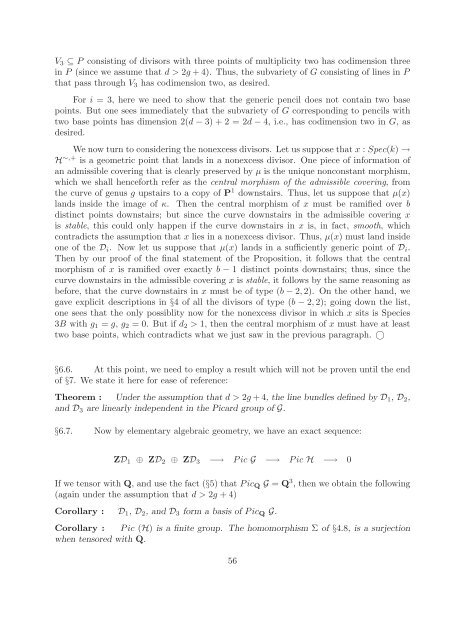The Geometry of the Compactification of the Hurwitz Scheme
The Geometry of the Compactification of the Hurwitz Scheme
The Geometry of the Compactification of the Hurwitz Scheme
You also want an ePaper? Increase the reach of your titles
YUMPU automatically turns print PDFs into web optimized ePapers that Google loves.
V 3 ⊆ P consisting <strong>of</strong> divisors with three points <strong>of</strong> multiplicity two has codimension three<br />
in P (since we assume that d>2g + 4). Thus, <strong>the</strong> subvariety <strong>of</strong> G consisting <strong>of</strong> lines in P<br />
that pass through V 3 has codimension two, as desired.<br />
For i = 3, here we need to show that <strong>the</strong> generic pencil does not contain two base<br />
points. But one sees immediately that <strong>the</strong> subvariety <strong>of</strong> G corresponding to pencils with<br />
two base points has dimension 2(d − 3) + 2 = 2d − 4, i.e., has codimension two in G, as<br />
desired.<br />
We now turn to considering <strong>the</strong> nonexcess divisors. Let us suppose that x : Spec(k) →<br />
H ∼,+ is a geometric point that lands in a nonexcess divisor. One piece <strong>of</strong> information <strong>of</strong><br />
an admissible covering that is clearly preserved by μ is <strong>the</strong> unique nonconstant morphism,<br />
which we shall henceforth refer as <strong>the</strong> central morphism <strong>of</strong> <strong>the</strong> admissible covering, from<br />
<strong>the</strong> curve <strong>of</strong> genus g upstairs to a copy <strong>of</strong> P 1 downstairs. Thus, let us suppose that μ(x)<br />
lands inside <strong>the</strong> image <strong>of</strong> κ. <strong>The</strong>n <strong>the</strong> central morphism <strong>of</strong> x must be ramified over b<br />
distinct points downstairs; but since <strong>the</strong> curve downstairs in <strong>the</strong> admissible covering x<br />
is stable, this could only happen if <strong>the</strong> curve downstairs in x is, in fact, smooth, which<br />
contradicts <strong>the</strong> assumption that x lies in a nonexcess divisor. Thus, μ(x) must land inside<br />
one <strong>of</strong> <strong>the</strong> D i . Now let us suppose that μ(x) lands in a sufficiently generic point <strong>of</strong> D i .<br />
<strong>The</strong>n by our pro<strong>of</strong> <strong>of</strong> <strong>the</strong> final statement <strong>of</strong> <strong>the</strong> Proposition, it follows that <strong>the</strong> central<br />
morphism <strong>of</strong> x is ramified over exactly b − 1 distinct points downstairs; thus, since <strong>the</strong><br />
curve downstairs in <strong>the</strong> admissible covering x is stable, it follows by <strong>the</strong> same reasoning as<br />
before, that <strong>the</strong> curve downstairs in x must be <strong>of</strong> type (b − 2, 2). On <strong>the</strong> o<strong>the</strong>r hand, we<br />
gave explicit descriptions in §4 <strong>of</strong> all <strong>the</strong> divisors <strong>of</strong> type (b − 2, 2); going down <strong>the</strong> list,<br />
one sees that <strong>the</strong> only possiblity now for <strong>the</strong> nonexcess divisor in which x sits is Species<br />
3B with g 1 = g, g 2 =0. Butifd 2 > 1, <strong>the</strong>n <strong>the</strong> central morphism <strong>of</strong> x must have at least<br />
two base points, which contradicts what we just saw in <strong>the</strong> previous paragraph. ○<br />
§6.6. At this point, we need to employ a result which will not be proven until <strong>the</strong> end<br />
<strong>of</strong> §7. We state it here for ease <strong>of</strong> reference:<br />
<strong>The</strong>orem : Under <strong>the</strong> assumption that d>2g +4, <strong>the</strong> line bundles defined by D 1 , D 2 ,<br />
and D 3 are linearly independent in <strong>the</strong> Picard group <strong>of</strong> G.<br />
§6.7. Now by elementary algebraic geometry, we have an exact sequence:<br />
ZD 1 ⊕ ZD 2 ⊕ ZD 3 −→ Pic G −→ Pic H −→ 0<br />
If we tensor with Q, and use <strong>the</strong> fact (§5) that Pic Q G = Q 3 , <strong>the</strong>n we obtain <strong>the</strong> following<br />
(again under <strong>the</strong> assumption that d>2g +4)<br />
Corollary : D 1 , D 2 ,andD 3 form a basis <strong>of</strong> Pic Q G.<br />
Corollary : Pic (H) is a finite group. <strong>The</strong> homomorphism Σ <strong>of</strong> §4.8, is a surjection<br />
when tensored with Q.<br />
56

















